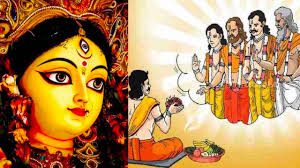
Mahalaya Amavasya Puja is a deeply significant Hindu ritual observed on the new moon day (Amavasya) that marks the beginning of the Devi Paksha and the end of Pitru Paksha. It usually falls in the month of Bhadrapada or Ashwin (September–October), depending on the lunar calendar. This day is devoted to honoring and offering prayers to one’s ancestors (Pitru Devatas) and seeking their blessings for peace and prosperity.
The word “Mahalaya” means “great destruction,” symbolizing the spiritual cleansing and the end of the ancestral fortnight. It is believed that on this day, the souls of ancestors descend to Earth to bless their descendants, and performing Shraddha rituals and Tarpanam helps them attain liberation (moksha).
Mahalaya Amavasya Puja begins early in the morning with ritual bathing, followed by Tarpana—offering water mixed with black sesame seeds, rice, and darbha grass to ancestors while reciting their names and mantras. This is often performed by the male members of the family, especially the eldest son, at riverbanks or sacred water bodies.
If a Shraddha ceremony (ritual meal for ancestors) is performed, Pind Daan (offering of rice balls) and feeding of Brahmins or poor people are important components. Food offerings include kheer, puri, seasonal vegetables, and other favorite dishes of the ancestors.
In some regions, this day also marks the invocation of Goddess Durga, especially in Bengal, where it is believed she begins her journey to Earth. The chanting of Devi Mahatmyam and Durga Stotras may be included in the puja.
Performing Mahalaya Amavasya Puja with sincerity helps in pacifying ancestral souls, removing family obstacles, and bringing harmony, blessings, and prosperity to the household.

